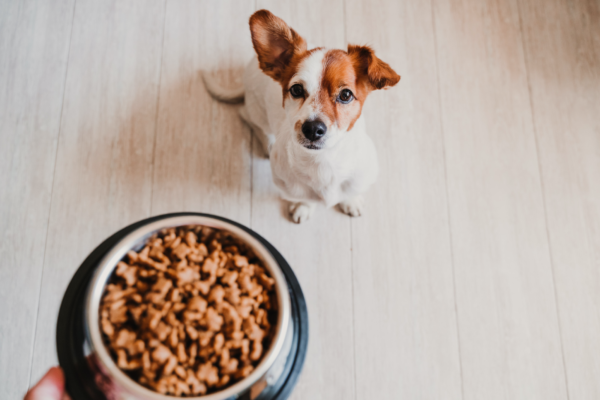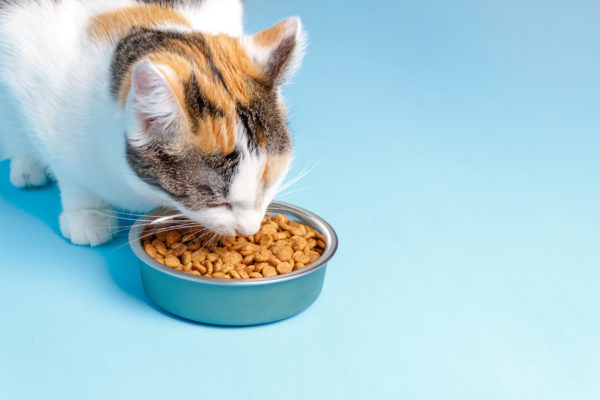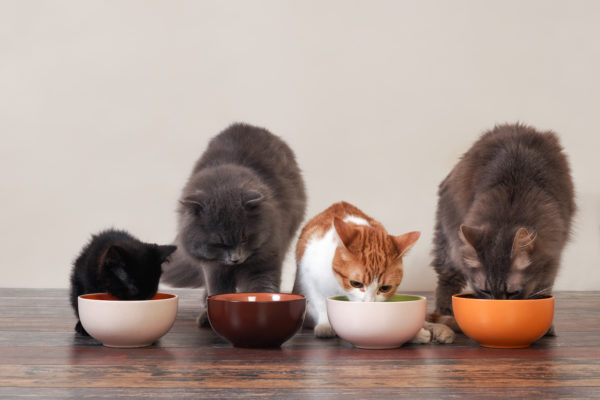GRAIN-FREE PET FOOD: WHAT THE SCIENCE SAYS
GRAINS AND CEREALS: WHAT EXACTLY ARE THEY?
In order to properly evaluate the integration of grains and cereals into your pet’s diet, it is important to understand what exactly they are, so that you can start your reflection on a strong base of knowledge! Cereals are dry seeds harvested from flowering plants. They can be divided into 2 groups:
- Cereals: wheat, barley, oats, rice, corn, millet, rye, sorghum
- Pseudo-cereals: buckwheat, quinoa, chia seeds
Note: When it comes to pet food, the terms “grain-free” and “cereal-free” are synonymous. We use them interchangeably in this post.
WHY ARE GRAINS USED IN CAT AND DOG FOOD?
Cereals are an excellent and sustainable source of fibre, protein, and vitamins. Once processed, grains can be digested and metabolized by cats and dogs. That’s why they’re a common ingredient in pet food.
DEBUNKING THE IMPLIED BENEFITS OF GRAIN-FREE PET FOOD
Grain-free pet food manufacturers tout a number of supposed benefits of feeding your pet a grain-free diet, but in reality, there’s no actual evidence that proves these foods are healthier for your pet. Now that’s food for thought!
Let’s break down their claims.
“GRAIN-FREE FOODS INCREASE SATIETY, MAKING PETS FEEL FULLER LONGER SO THEY EAT LESS OFTEN”
Grain-free pet foods often use other types of carbohydrates as a substitute. These alternatives tend to be much lower in fibre content so they actually speed up your pet’s digestion, reducing their satiety and leaving them with an empty stomach. So, in reality, these diets do the opposite of what they claim to do.
“GRAIN-FREE FOOD REDUCES THE RISK OF OBESITY”
There are no scientific studies suggesting that grains play a role in pet obesity—quite the opposite, in fact! The scientific literature suggests that carbohydrates, often provided by grains, can alleviate hunger and help dogs lose weight.
“GRAIN-FREE FOOD IMPROVES DIGESTIBILITY”
Digestibility refers to how easily your pet’s body absorbs nutrients from their food. If your pet’s food is digestible, the nutrients will be absorbed by the GI tract and play their vital role in energy production, tissue repair, and organ function. If your pet can’t properly digest their food, they could develop nutritional and energy deficiencies.
Do grains really have lower digestibility? It depends on how they’re processed. For example, corn is a key ingredient in pet food, but it’s processed into meal to increase it’s digestibility so your pet can get the maximum benefit. The 87.5% digestibility index of cornmeal is higher than that of meat and bone meal or even fresh meat, as shown in the table below.

Source: Murray, et al. “Raw and Rendered Animal By-Products as Ingredients in Dog Diets.” Journal of Nutrition, Vol. 128, No. 12, Dec. 1998, pp. 2812S–2815S.
“GRAIN-FREE FOOD REDUCES THE RISK OF FOOD ALLERGIES OR ADVERSE FOOD REACTIONS IN PETS, INCLUDING TO GLUTEN”
Some cats and dogs may develop food allergies, but these aren’t usually caused by corn or other grains in pet foods.
According to BMC Veterinary Research, the most frequently reported food allergens for dogs involve:
- Beef (34%)
- Dairy products (17%)
- Chicken (15%)
- Wheat (13%)
And the most common food allergens for cats are:
- Beef (18%)
- Fish (17%)
- Chicken (5%)
- Wheat (4%)
As you can see, not very many pets are allergic to the grains contained in their food. Still, your vet may recommend a grain-free diet in certain situations. They may suggest a trial run if they suspect your pet might have food allergies (also known as adverse food reactions) to see if their symptoms improve. Of course, your vet will make sure that the recommended food is complete and balanced in order to meet the nutritional needs of your furry companion.
What about gluten allergies?
Be aware that the terms “grain-free” and “gluten-free” don’t mean the same thing. Wheat, barley, and rye contain gluten, but not all grains do!
So, grain-free foods are gluten-free? Theoretically that’s true, unless they contain ingredients that are hidden sources of gluten. Studies have shown that cross-contamination in commercial dog foods is common in the manufacturing process, so these foods may not be completely free of the ingredients they say they are. That means grain-free foods could potentially still contain gluten. Quality food manufacturers, on the other hand, take every possible precaution to avoid cross-contamination.
Wheat gluten intolerance exists, but it is very rare in dogs. In fact, it has only been reported in a small subset of Irish setters in the United Kingdom. So, unless your vet recommends a gluten-free diet, there’s no reason to deprive your pet of such a rich source of protein.
“GRAIN-FREE FOOD CONTAINS FEWER CARBOHYDRATES THAN FOOD WITH GRAINS”
You have to ask yourself: Why you would want a pet food that’s lower in carbohydrates in the first place, when carbs provide much-needed energy? When your pet’s food contains enough carbohydrates to meet their energy requirements, their body doesn’t need to use protein for energy, making it available for tissue growth and repair.
And in any event, grain-free foods use other ingredients as a substitute and still contain carbohydrates—sometimes in much higher amounts than their grain-containing counterparts.
The advantage of grains is that they’re an outstanding source of carbohydrates, protein, and fat, whereas alternative ingredients like potatoes, chickpeas, taro, and tapioca tend to be starchy, with little or no protein or fat.
To understand the role these nutrients play in your pet’s body, read our post on the topic.
GRAIN-FREE FOOD AND THE RISK OF DEVELOPING DILATED CARDIOMYOPATHY (DCM)
Have you heard? The Food and Drug Administration (FDA) is investigating a potential link between dilated cardiomyopathy, a heart disease, and certain grain-free foods.
There have been recent reports of canine dilated cardiomyopathy (DCM) in dogs eating certain diets, many labeled as “grain-free” and formulated with a high proportion of peas, legume seeds, and/or potatoes as an alternative to grains.
While certain breeds of dogs are naturally predisposed to developing dilated cardiomyopathy, the FDA has observed cases of DCM in breeds not known to have a genetic predisposition.
The causal relationship between developing DCM and consuming a grain-free, legume-based diet has yet to be established, but the FDA investigation is ongoing.
WHAT IT ALL MEANS
Are you feeding your cat or dog a grain-free diet, or considering making the switch? We strongly recommend discussing it with your veterinary team first. They can answer your questions, work with your needs, and recommend a balanced diet for your pet.
REFERENCES
Case LP, Carey DP, Hirakawa DA, Daristotle L. “Digestion and Absorption” and “Nutrient Content of Pet Foods,” Canine and Feline Nutrition, 2nd ed., Mosby, St. Louis, 2000, pp. 60–63, 175–185.
Gross KL, Yamka RM, Khoo C, et al. “Nutrients,” Small Animal Clinical Nutrition, 5th ed., Mark Morris Institute, Topeka, 2010, pp. 58–60.
Crane SW, Cowell CS, Stout NP, et al. “Commercial Pet Foods,” Small Animal Clinical Nutrition, 5th ed., Mark Morris Institute, Topeka, 2010, pp. 157–185.
Penn State Agronomy Guide 2017–2018, Part 1, Section 4: “Corn.” http://agguide.agronomy.psu.ed… Accessed 10/27/18
Gross KL, Jewell DE, Yamka RM, et al. “Macronutrients,” Small Animal Clinical Nutrition, 5th ed., Mark Morris Institute, Topeka, 2010, pp. 89–96.
Roudebush P, Guilford WG, Jackson HA. Adverse Reactions to Food. Small Animal Clinical Nutrition, 5th ed. Mark Morris Institute, Topeka, 2010. p. 615
Fascetti AJ, Delaney SJ. “Commercial and Home Prepared Diets,” Applied Veterinary Clinical Nutrition, Wiley-Blackwell, Ames, 2012, pp. 97–98.
Huston, L. “How to Know If Your Pet Needs Gluten or Grain Free Dog Food,” Pet MD. https://www.petmd.com/dog/centers/nutrition/evr_dg_why-grain-free-dog-food-may-not-be-the-best-choice. Accessed 10/27/18
Freeman LM. “A broken heart: Risk of heart disease in boutique or grain-free diets and exotic ingredients.”



